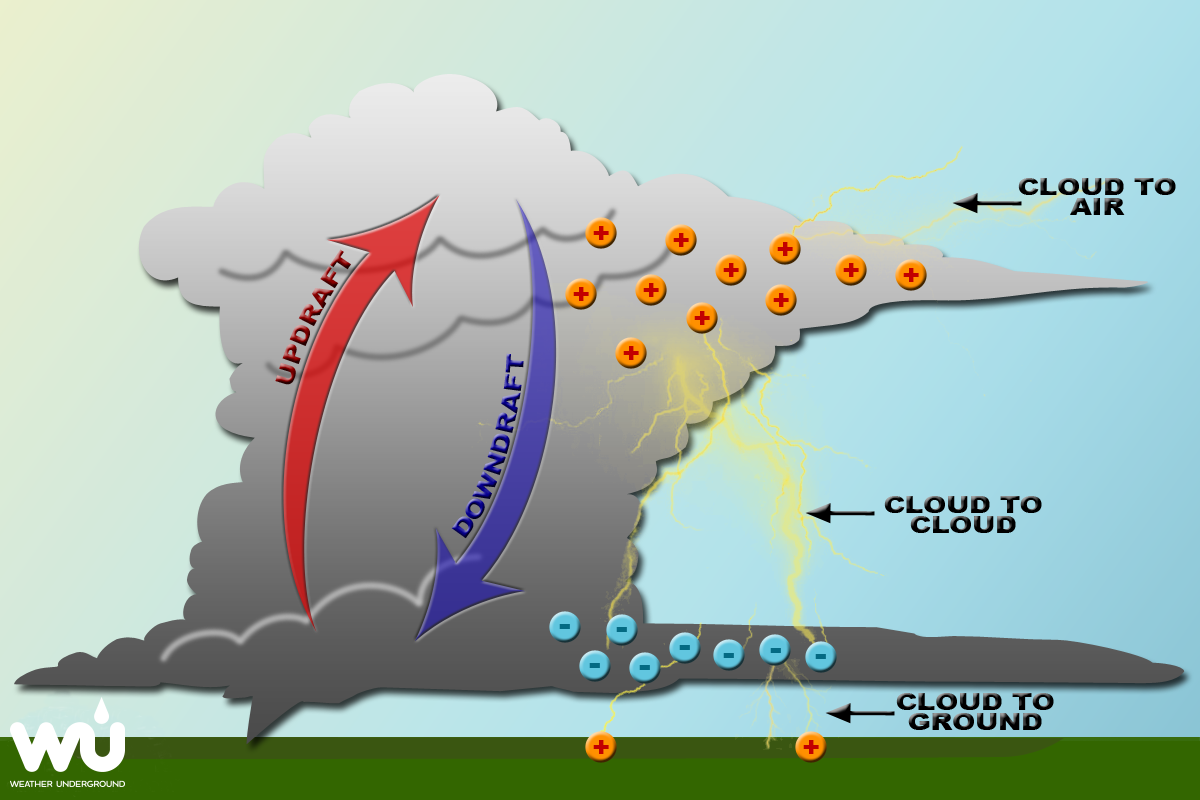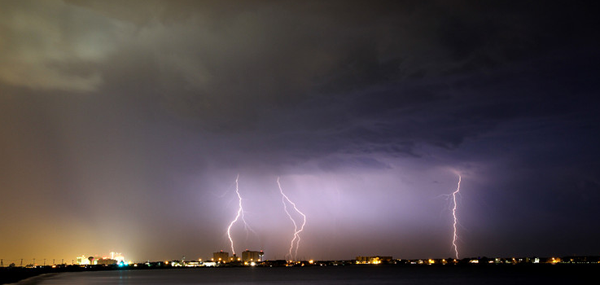View the U.S. Severe Weather Map

How Lightning Forms
Lightning has fascinated and excited humans for as long as they have watched the skies. Although meteorologists understand the cloud conditions necessary to produce it, lightning cannot be forecasted. At any moment, there are as many as 1,800 thunderstorms in progress somewhere on earth and each is producing deadly lightning. Lightning detection systems in the U.S. see an average of 25 million strokes of lightning each year, from some 100,000 storms. It is estimated that the earth is struck by 100 lightning bolts every second.
The clouds at the high levels of the thunderstorm are made of ice crystals. The formation of ice in a cloud is an important element in the development of lightning. Those storms that fail to produce large numbers of ice crystals may also fail to produce a lot of lightning. Strong rising and sinking motions within the cloud are important too, as they enhance collisions among cloud particles causing a separation of electrical charges. Positively charged ice crystals rise to the top of the thunderstorm and negatively charged ice particles and hailstones drop to the middle and lower parts of the storm.
As the differences in charges continue to increase, positive charges rise up taller objects such as trees, houses and telephone poles. The charge can also move up you, causing your hair to stand on end! This is natures final way of warning you that lightning can strike near you very soon.
If the negatively charged area at the bottom of the storm gets large enough, it sends out a channel toward the ground called a step leader. It is invisible to the human eye and moves in steps toward the ground. When the step leader nears the ground, or a target such as a radio tower, it repels all the negative charges in the surrounding area and attracts all the positive charge. As the positive charges collect in high enough concentration, they send out small bolts of ground to air lightning called streamers. If the streamers can make contact with the step leader, an electric current wave propagates up the channel as a bright pulse -- lightning!
And of course, with lightning comes thunder. Lightning heats the surrounding air to as much as 50,000 degrees Fahrenheit, which is five times the temperature of the surface of the sun. When air is heated, it expands, and this expansion is what's causing the sound of thunder. The expansion is happening faster than the speed of sound, which creates a sonic boom.

Lightning Medical Impacts
Lightning usually claims only one or two victims at a time and usually does not cause the mass destruction left in the wake of tornadoes or hurricanes. Lightning generally receives less attention than any other weather hazard.
During a thunderstorm, each flash of cloud to ground lightning is a potential killer. However, lightning deaths can be prevented if people are aware of the dangers and seek shelter.
Lightning can strike as much as 10 miles away from the rain area in a thunderstorm. That is about the distance that you are able to hear the thunder from the storm. If you can hear the thunder from a storm, you are close enough to be struck by lightning.
Where organized sports activities are taking place, coaches, umpires, referees or camp counselors must protect the safety of the participants and spectators by stopping the activities so that participants and spectators can get to a safe place before the lightning threat becomes significant.
Lightning Facts
- An average of 85 lightning fatalities occur each year
- Approximately 10% of the people struck by lightning are killed
- 70% of lightning strike victims suffer long-term effects
- Approximately 400 people survive lightning strikes each year
- The primary cause of death from lighting is cardiac arrest
- Unlike high voltage electrical injuries with which massive internal tissue damage may occur, lightning seldom causes substantial burns
- Most lightning injuries and deaths can be prevented with advance planning and being aware of developing weather situations
- A NOAA Weather Radio can help keep you informed with the latest thunderstorm information

Lightning Safety
Being outdoors is the most dangerous place to be during a lightning storm. The National Weather Service advises that when you hear thunder or see lightning to quickly move indoors or into a hard topped vehicle and remain there until well after the storm has passed.
Any location is dangerous durning a lightning storm, however, some areas are more dangerous than others. Some of the riskiest locations include:
- Anywhere near the water
- Boating
- Fishing
- Swimming
- Activities on the beach
- Areas near tall trees (especially isolated trees)
- Golf course
- Picnic areas
- Hiking trails
- High terrains such as hill tops and ridges
- High places such as house roofs during construction
- Open areas like fields
Outdoor Safety Rules
Knowing outdoor safety rules can help save your life or that of loved ones.
When lightning approaches, get inside a completely enclosed building. Car-ports, open garages, storage sheds, metal sheds, and covered patios are not safe shelters.
If no enclosed building is available, get inside a hard-topped, all metal vehicle.
Get out of the water! Get off the beach and out of small boats and canoes. If caught in a boat, crouch down in the center of the boat away from metal hardware. Avoid standing in puddles of water, even if wearing rubber boots.
If you cannot reach shelter, avoid being the tallest object in the area. Do not take shelter under a tree. If you are in the woods, find shelter under the shortest trees.
If only isolated trees are nearby, crouch on the balls of your feet. A rule of thumb to follow is to stay twice as far away from a tree as it is tall. Don't lie on the ground.
Avoid leaning against vehicles and get off bicycles and motorcycles.

Indoor Safety Rules
When lightning strikes a building, house or other structure, it follows metal conductors such as electrical wiring, plumbing and telephone lines from the structure to the ground. When this process occurs, it usually leaves the inhabitants unharmed.
Once lightning enters the home it can surge through the electrical, phone, plumbing and radio/television reception systems. It can also travel through any metal wires or bars in concrete walls or flooring as well as windows and doors. It is important to avoid these conductors during an electrical storm.
Phone use is the leading cause of lightning injuries within the home. Lightning can travel long distances in both phone and electrical wiring, especially in rural areas where other conductors are limited.
Basements should be used with caution during lightning storms (unless there's a tornado warning!) because they usually contain conductors. Avoid contact with washers and dryers since they not only have contacts with the plumbing and electrical systems, but also have an electrical path to the outside through the dryer vent. Concrete floors should also be avoided as they usually contain some form of reinforcement which can easily become electrified by a nearby lightning strike. Avoid bathing during a lightning storm as the household plumbing can carry a deadly current.